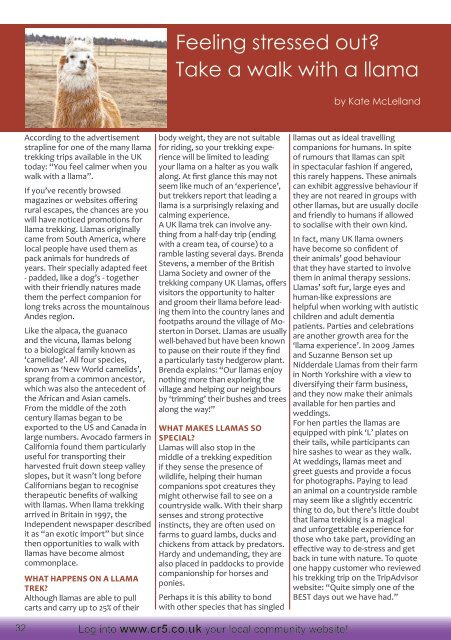Create successful ePaper yourself
Turn your PDF publications into a flip-book with our unique Google optimized e-Paper software.
Feeling stressed out?<br />
Take a walk with a llama<br />
by Kate McLelland<br />
According to the advertisement<br />
strapline for one of the many llama<br />
trekking trips available in the UK<br />
today: “You feel calmer when you<br />
walk with a llama”.<br />
If you’ve recently browsed<br />
magazines or websites offering<br />
rural escapes, the chances are you<br />
will have noticed promotions for<br />
llama trekking. Llamas originally<br />
came from South America, where<br />
local people have used them as<br />
pack animals for hundreds of<br />
years. Their specially adapted feet<br />
- padded, like a dog’s - together<br />
with their friendly natures made<br />
them the perfect companion for<br />
long treks across the mountainous<br />
Andes region.<br />
Like the alpaca, the guanaco<br />
and the vicuna, llamas belong<br />
to a biological family known as<br />
‘camelidae’. All four species,<br />
known as ‘New World camelids’,<br />
sprang from a common ancestor,<br />
which was also the antecedent of<br />
the African and Asian camels.<br />
From the middle of the 20th<br />
century llamas began to be<br />
exported to the US and Canada in<br />
large numbers. Avocado farmers in<br />
California found them particularly<br />
useful for transporting their<br />
harvested fruit down steep valley<br />
slopes, but it wasn’t long before<br />
Californians began to recognise<br />
therapeutic benefits of walking<br />
with llamas. When llama trekking<br />
arrived in Britain in 1997, the<br />
Independent newspaper described<br />
it as “an exotic import” but since<br />
then opportunities to walk with<br />
llamas have become almost<br />
commonplace.<br />
WHAT HAPPENS ON A LLAMA<br />
TREK?<br />
Although llamas are able to pull<br />
carts and carry up to 25% of their<br />
body weight, they are not suitable<br />
for riding, so your trekking experience<br />
will be limited to leading<br />
your llama on a halter as you walk<br />
along. At first glance this may not<br />
seem like much of an ‘experience’,<br />
but trekkers report that leading a<br />
llama is a surprisingly relaxing and<br />
calming experience.<br />
A UK llama trek can involve anything<br />
from a half-day trip (ending<br />
with a cream tea, of course) to a<br />
ramble lasting several days. Brenda<br />
Stevens, a member of the British<br />
Llama Society and owner of the<br />
trekking company UK Llamas, offers<br />
visitors the opportunity to halter<br />
and groom their llama before leading<br />
them into the country lanes and<br />
footpaths around the village of Mosterton<br />
in Dorset. Llamas are usually<br />
well-behaved but have been known<br />
to pause on their route if they find<br />
a particularly tasty hedgerow plant.<br />
Brenda explains: “Our llamas enjoy<br />
nothing more than exploring the<br />
village and helping our neighbours<br />
by ‘trimming’ their bushes and trees<br />
along the way!”<br />
WHAT MAKES LLAMAS SO<br />
SPECIAL?<br />
Llamas will also stop in the<br />
middle of a trekking expedition<br />
if they sense the presence of<br />
wildlife, helping their human<br />
companions spot creatures they<br />
might otherwise fail to see on a<br />
countryside walk. With their sharp<br />
senses and strong protective<br />
instincts, they are often used on<br />
farms to guard lambs, ducks and<br />
chickens from attack by predators.<br />
Hardy and undemanding, they are<br />
also placed in paddocks to provide<br />
companionship for horses and<br />
ponies.<br />
Perhaps it is this ability to bond<br />
with other species that has singled<br />
32 Log into www.cr5.co.uk your local community website!<br />
llamas out as ideal travelling<br />
companions for humans. In spite<br />
of rumours that llamas can spit<br />
in spectacular fashion if angered,<br />
this rarely happens. These animals<br />
can exhibit aggressive behaviour if<br />
they are not reared in groups with<br />
other llamas, but are usually docile<br />
and friendly to humans if allowed<br />
to socialise with their own kind.<br />
In fact, many UK llama owners<br />
have become so confident of<br />
their animals’ good behaviour<br />
that they have started to involve<br />
them in animal therapy sessions.<br />
Llamas’ soft fur, large eyes and<br />
human-like expressions are<br />
helpful when working with autistic<br />
children and adult dementia<br />
patients. Parties and celebrations<br />
are another growth area for the<br />
‘llama experience’. In 2009 James<br />
and Suzanne Benson set up<br />
Nidderdale Llamas from their farm<br />
in North Yorkshire with a view to<br />
diversifying their farm business,<br />
and they now make their animals<br />
available for hen parties and<br />
weddings.<br />
For hen parties the llamas are<br />
equipped with pink ‘L’ plates on<br />
their tails, while participants can<br />
hire sashes to wear as they walk.<br />
At weddings, llamas meet and<br />
greet guests and provide a focus<br />
for photographs. Paying to lead<br />
an animal on a countryside ramble<br />
may seem like a slightly eccentric<br />
thing to do, but there’s little doubt<br />
that llama trekking is a magical<br />
and unforgettable experience for<br />
those who take part, providing an<br />
effective way to de-stress and get<br />
back in tune with nature. To quote<br />
one happy customer who reviewed<br />
his trekking trip on the TripAdvisor<br />
website: “Quite simply one of the<br />
BEST days out we have had.”

















